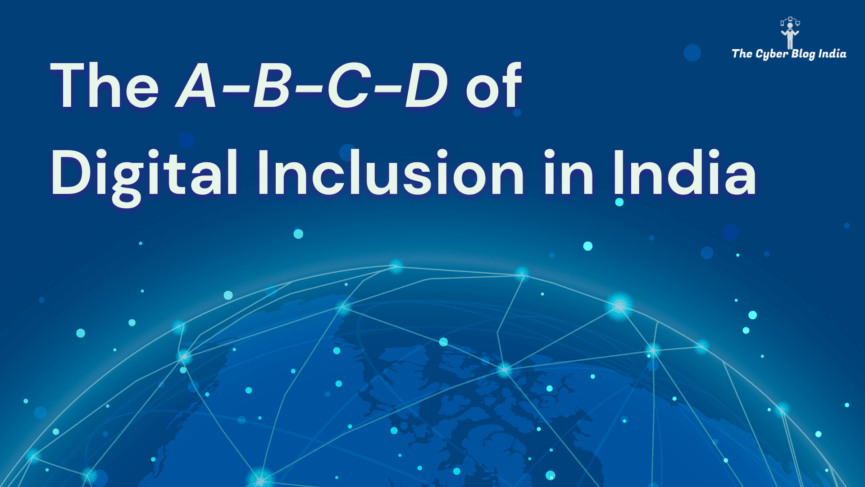The A-B-C-D of Digital Inclusion in India

Do you (and the people around you) have access to the Internet and related digital technologies?
Do you make use of these?
If you pick yes as your answer to these two questions, congratulations! You comprise one part of the 4.9 billion people (or 63% of the global population) who are online. One-third of the world, however, cannot say yes to this answer, for they lack access to these digital services. It is this divide that digital inclusion seeks to eliminate. According to the UN, digital inclusion refers to
“equitable, meaningful, and safe access to use, lead, and design of digital technologies, services, and associated opportunities for everyone, everywhere”.
It is not incidental that digital inclusion finds itself on the agenda of most governments and international organisations. Governments globally are ramping up their efforts to improve digital infrastructure and digital economies. In India, the government introduced the Digital India Programme in 2015 to improve the digital lives of citizens as well as the discharge of public services. It isn’t all just spinning wheels: the country is expected to grow to 900 million Internet users by 2025, with most of the population currently active online. However, the digital divide still persists — state, gender, and rural/urban divides make this development relatively exclusive.
Key Components of Digital Inclusion
1. Access
There are a ton of factors that can hinder access to digital products and services. The affordability of digital products is one. However, the Indian smartphone revolution has tackled this already. Statista found that India’s smartphone penetration rate stood at 71% in 2023 and will reach a marked 96% by 2040. Affordability alone cannot solve the problem, unfortunately; a robust digital infrastructure is necessary to maximise the fruits of the wide accessibility of digital products.
Programs like BharatNet and the National Broadband Mission and policies like the National Digital Communications Policy have emphasised the need for enhanced broadband infrastructure in the country, especially in Gram Panchayats spread across rural India. Rural and remote regions are another hindrance to access to digital products and services, and their geographical location or cultural practices restrict technological usage.
Digital literacy skills foster a confident and critical use of a full range of digital technologies. According to UNESCO, digital literacy is the fourth pillar of foundational literacy. However, per the Ministry of Labour & Employment, only 38% of Indian households are digitally literate. This undermines the effective evolution of the digitally ill-equipped population.
2. Broadband Initiatives
Broadband refers to high-speed Internet connectivity that adequately strengthens digital inclusion in society. Often, community broadband initiatives become crucial in facilitating Internet access across the country. Besides some initiatives mentioned above, the Indian government has sought to provide faster connectivity through programs like the Digital Village Project.
3. Community Engagement and Content Accessibility
No program can be fulfilled sans engagement with the community. Digital inclusion requires community engagement through capacity-building, upskilling programs, and cultural consideration concerning technology usage. The Indian government’s Community Information Centers (CICs) empower IT education in rural India and offer optimal Internet connectivity, training programs, and e-governance services for the rural populace.
Moreover, inclusion in tech necessitates including people with disabilities (visual/auditory/motor/cognitive/neurological) and literacy issues in the effective usage of tech. This involves the meaningful use of User Experience (UX) and User Interface (UI) design to cater to the needs of diverse users. Subsequently, legal standards to make Indian government websites disability-friendly have been set, though few of them are in practice.
4. Digital Rights
A lesser talked-about facet of digital inclusion is the relevance of digital rights. These rights facilitate the proactive participation of the citizenry in the digital space while protecting their privacy and right to speech and expression, among other things. For this reason, the government has actively worked to develop laws such as the Digital Personal Data Protection (DPDP) Act, the proposed Digital India Act, etcetera.
Conclusion
It doesn’t stop here; the concept of digital inclusion remains expansive. We are yet to uncover how digital inclusion intersects with different identities, and how it enables more niche forms of social improvement. This article is part of a series of three articles, the rest of which will come in the next few weeks. The most definitive element of this century has been tech; if we cannot successfully improve access to technological products for everyone despite being the second-largest technological population, we are doing something wrong.
Featured Image Credits: Image by rawpixel.com on Freepik
